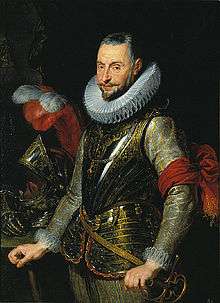Palatinate campaign
| ||||||||||||||||||||||||||
The Palatinate Campaign, or the Spanish conquest of the Palatinate,[6] were a series of sieges, battles and conquests of the Palatinate Phase of the Thirty Years' War, that were carried out by Spain's Tercios of the Army of Flanders, under Don Ambrosio Spinola, and the Imperial-Spanish troops under Johan Tzerclaes, Count of Tilly and Don Gonzalo Fernández de Córdoba.[2][6] The Spanish troops took advantage of Frederick's predicament by invading the German Protestant Palatinate in 1620 and conquering it by the end of 1622.[6]
Imperial-Spanish conquest of the Palatinate
The Thirty Years' War began in 1618 with the Bohemian Revolt, when the authorities of this kingdom offered their throne to the Protestant Frederick V of the Palatinate, who accepted, initiating a conflict between the Protestant Union led by Frederick and the House of Habsburg.[7] Two years after the outbreak of the war the situation had apparently stalled, but in reality the Habsburgs through diplomatic maneuvers, were able to politically isolate Frederick, between whose hits highlighted Spain's entry into the conflict.[7]
In August, 1620, Spinola and 25,000 soldiers from the Army of Flanders began their march from Brussels, and in early September they entered the Lower Palatinate, taking Kreuznach, Oppenheim, and the Bergstrasse district, and on 1 October Bacharach.[4] Tilly and the army of the "League", along with the other Spanish army under Córdoba soon followed, after joining at Wimpfen. It was not until late 1622, that both Heidelberg and Mannheim, the two leading cities in the Lower Palatinate, fell to the Imperial-Spanish army.[2][8]
End of campaign
The campaign ended when Gonzalo Fernández de Córdoba and the Count of Tilly sacked Heidelberg, the capital of German Calvinism, occupying the Upper Palatinate.[8][9] Spain's troops under Spinola from the Spanish Netherlands attacked the Lower Palatinate and took it over quickly.[9] The unfortunate Frederick fled into exile in the United Provinces.[6]
The Spanish took control of the western part of the Palatinate[6] (to gain the access route from Italy to the Netherlands through the Spanish Road), and the Duke Maximilian of Bavaria took the rest of the territory.
English Involvement
.jpg)
.svg.png)
The English troops, who were garrisoned in the towns of Frankenthal and Mannheim in the Lower Palatinate, could do little to stop the advance of Gonzalo de Córdoba.[10] On his return to the Spanish Netherlands, Ambrosio Spinola captured Jülich in 1621, reversing Maurice's success of 1610, and cutting off the supply route between the Low Countries and the Upper Palatinate.[10] In the Palatinate, the situation went from bad to worse for the Protestant cause. Mainz fell to Córdoba in August 1621. Tilly's Catholic troops laid siege to Heidelberg, which capitulated in September, 1622, and Mannheim followed in early November.
The English garrison at Frankenthal held on during the winter months but it was recognized that it was futile to hold on to the fortification in light of the noose tightening around the town.[10] In March, 1623, the English, knowing that they could not alter the situation in the Palatinate, handed over Frankenthal to the Spanish.[10] Vere's troops fought bravely and stoutly defended the fortifications they garrisoned, but they were finally overwhelmed by the might of the combined Imperial and Spanish forces.[10]

Consequences
Reestablished as King of Bohemia, Emperor Ferdinand II declared Bohemia a hereditary Habsburg possession,[6] confiscated the land of the Protestant nobles,[6] and established Catholicism as the sole religion.[6] On August 6, 1623, the Protestant forces of Christian of Brunswick were destroyed by the combined Imperial and Spanish troops under the Count of Tilly in the Battle of Stadtlohn, and Frederick V, Elector Palatine, was forced to sign an armistice with Emperor Ferdinand II, thus ending the "Palatine Phase" of the Thirty Years' War.
Frederick V, already in exile in The Hague, and under growing pressure from his father-in-law, James I of England, to end his involvement in the war, was forced to abandon any hope of launching further campaigns. The Protestant rebellion had been crushed.
In 1624, the Kingdom of England, France, the United Provinces of the Netherlands, Sweden, Denmark, the Duchy of Savoy, the Republic of Venice, and Brandenburg would join in an Anti-Habsburg alliance to fight against Spain and the Holy Roman Empire. The Spanish renewed their attack on the Dutch after the Twelve Years' Truce, and on June 5, 1625, the Spaniards conquered the important Dutch fortress city of Breda. The forces of Catholicism seemed on the road to victory, but the war was far from over.[6]
See also
Notes
References
- Spielvogel, J Jackson. Western Civilization: Volume II: Since 1500 Wadsworth Publishing (2006) ISBN 978-0-534-64604-2
- Guthrie, P William. Battles of the Thirty Years War: From White Mountain to Nordlingen, 1618-1635 Greenwood Press (2001) ISBN 978-0-313-32028-6
- Pursell, C Brennan The Winter King: Frederick V of the Palatinate and the Coming of the Thirty Years' War Ashgate Publishing (2003) ISBN 978-0-7546-3401-0
- Sunshine, S Glenn. Ron Hill The Reformation for Armchair Theologians. Westminster John Knox Press, (2005) ISBN 978-0-664-22815-6
- Black, Jeremy European Warfare, 1494-1660. Routledge Publishing (2002) ISBN 978-0-415-27531-6
- Wilson, Peter H. (2009). The Thirty Years War: Europe's Tragedy. Harvard University Press. ISBN 978-0-674-03634-5.
- Lawrence, R David. The Complete Soldier: Military Books and Military Culture in Early Stuart England, 1603-1645. Brill Academic Publishing. ISBN 978-90-04-17079-7
- Josef V. Polišenský/Frederick Snider: War and society in Europe (1618-1648). Bristol: Cambridge University Press, 1978. ISBN 978-0-521-21659-3

